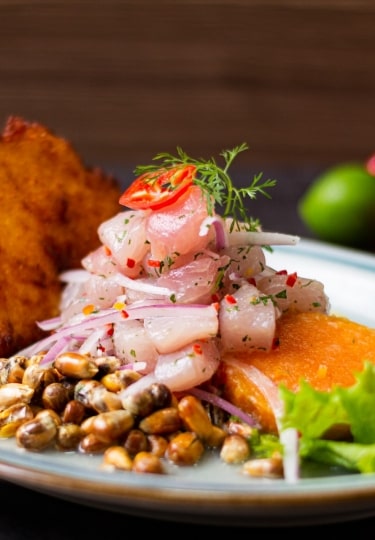South American food encompasses a large variety of cuisines. Food lovers will find a very tempting choice of dishes to try.
From Argentina’s dulce de leche to Peru’s ceviche, many may already be familiar. Others, such as Uruguay’s chevito or Ecuador’s bolon de verde are still awaiting their moment of fame.
A journey through South America is a chance to experience some rich flavors, hearty meals, and warm hospitality. Food is a universal language, enjoyed by all.
Here is some of the finest South American food to try.
Asado
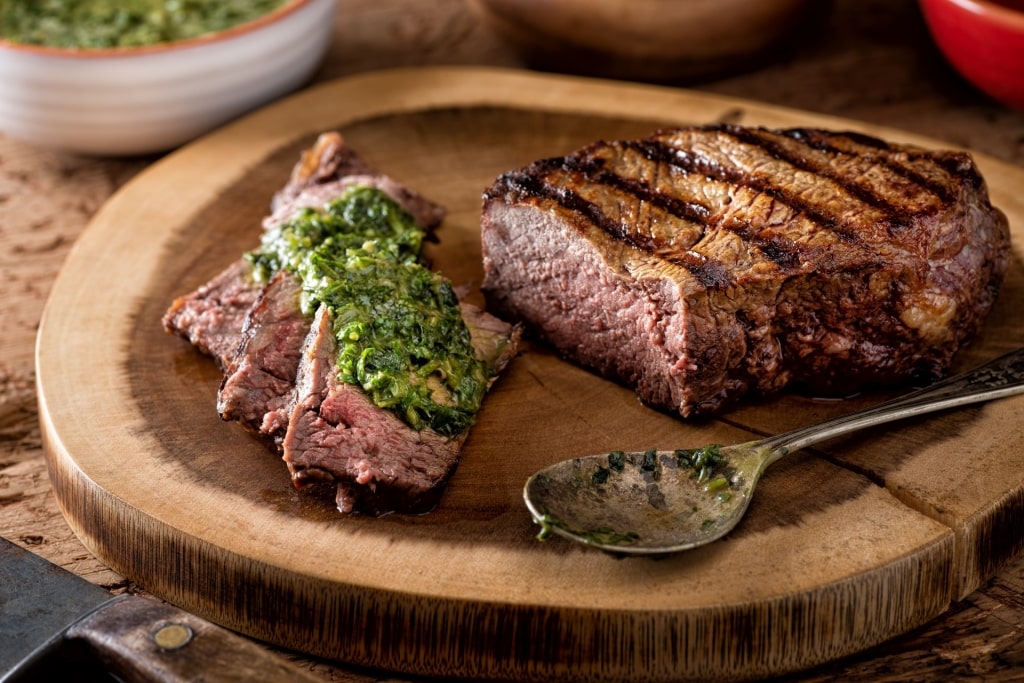
Asado
You won’t spend much time in Argentina, Uruguay, Chile, or Paraguay without coming across an asado. It’s a barbecue, but a social event as much as a chance to over-indulge in grilled meat.
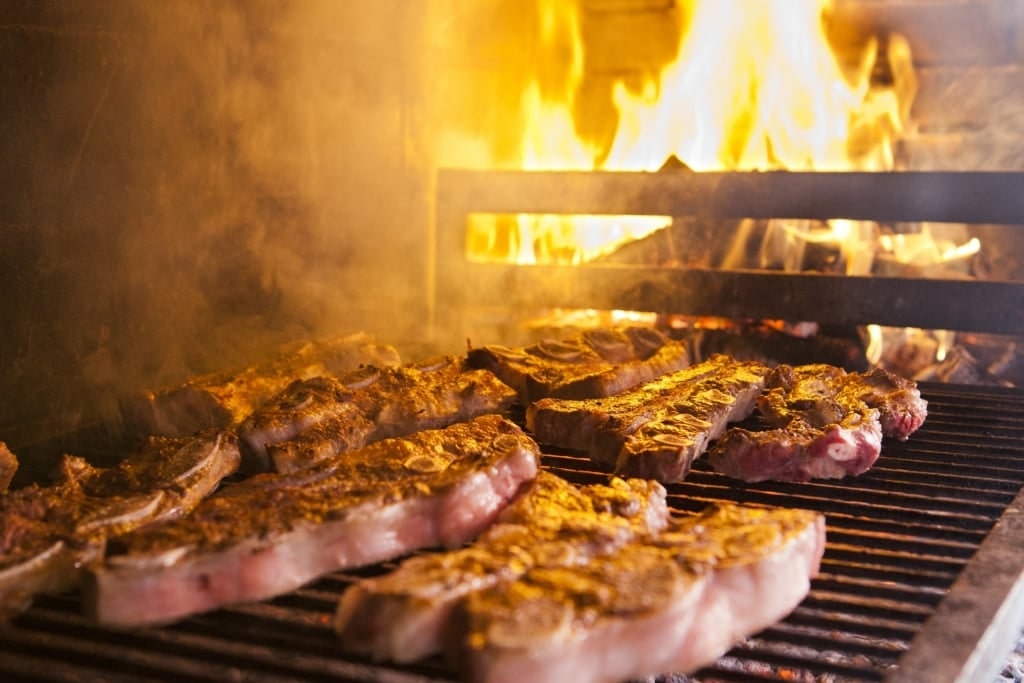
Asado
Whether it’s beef, pork, chicken, or sausage, it’s all cooked on the parrilla (grill) over wood or charcoal. Being South America, red wine is as popular as beer as an accompaniment.
Salad, or baked potato, are common sides, as with any BBQ. Cooking slowly (with some exceptions for tender cuts) is the key to a good asado—the meat should not be burnt.
Peruvian Ceviche
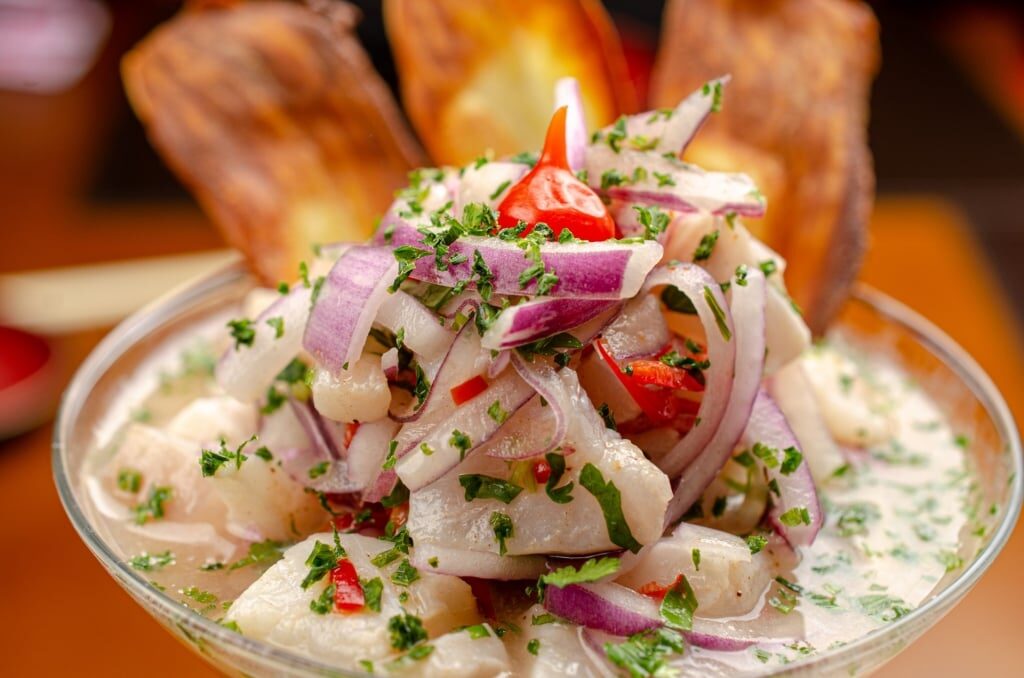
Peruvian ceviche
With roots going back 2,000 years to the pre-Hispanic Moche culture, Peru has given the world this delicious dish. In turn, it has now been influenced by Peruvian-Japanese chefs using sashimi techniques to produce tiradito (like ceviche, but without the marinade).
Ceviche uses bite-sized pieces of fresh, raw fish which is denatured in an acidic marinade. In Peru, the marinade is based on key lime, lemon or bitter orange.
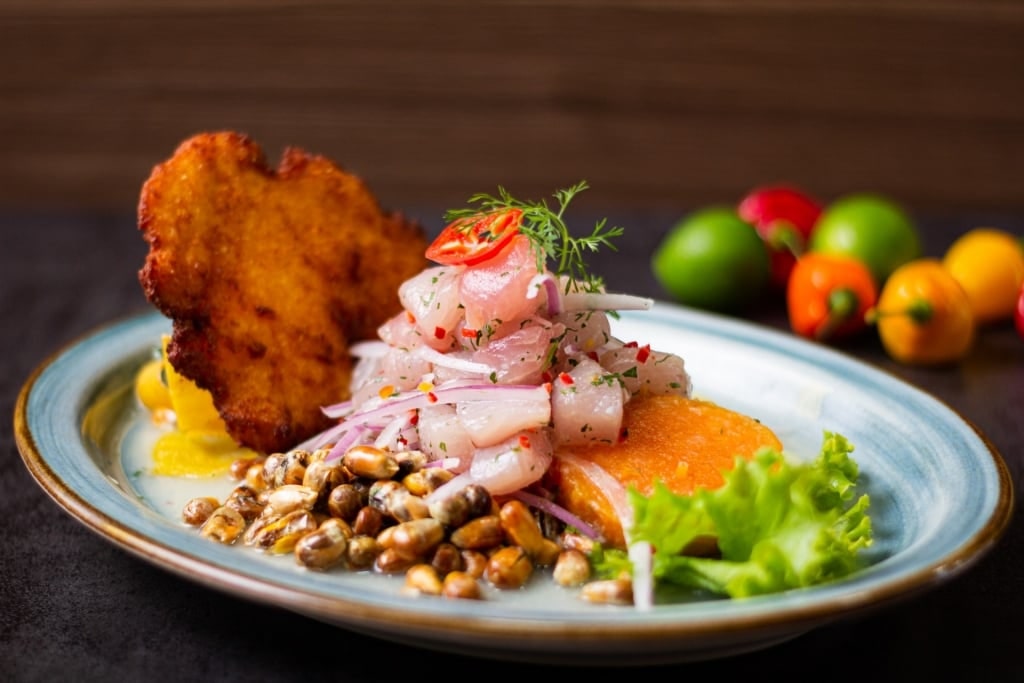
Peruvian ceviche
Extra flavor comes from onion, chili pepper, salt, coriander, and ginger. It is served with fried potato, plantain or sweet potato, and “leche de tigre”—a small glass of the marinade.
Arepas
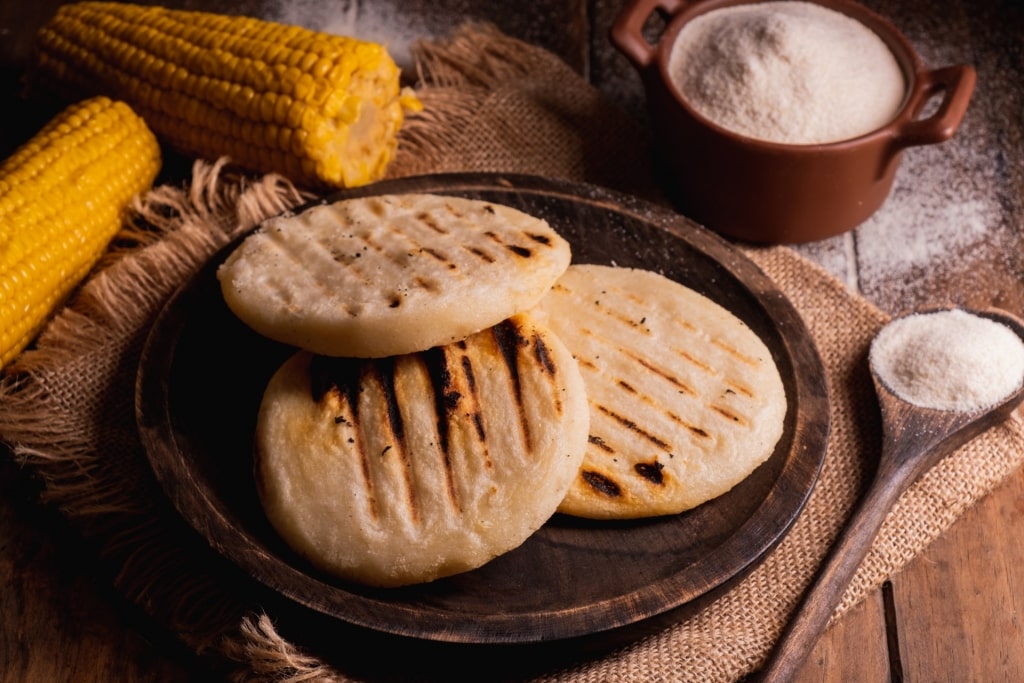
Arepas
Arepas are a form of unleavened bread, made with cornmeal flour. Cooked on the griddle, baked or fried, they are flat and round, with a crisp outer layer, and soft insides.
Particularly popular in Columbia and Venezuela, you may also find street vendors selling them in Mexico and Peru.
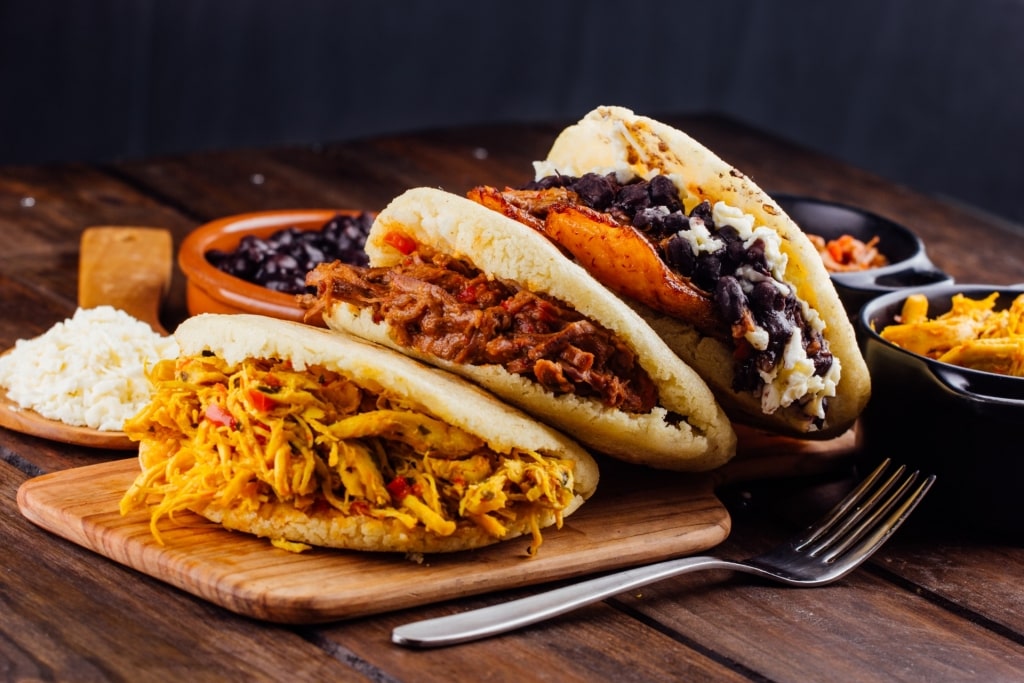
Arepas
They are eaten for breakfast, lunch and dinner, either as a sweet or savory. Popular toppings or fillings include honey, avocado with black beans, cheese, eggs, or anything else you might find in a sandwich or tortilla.
Cazuela
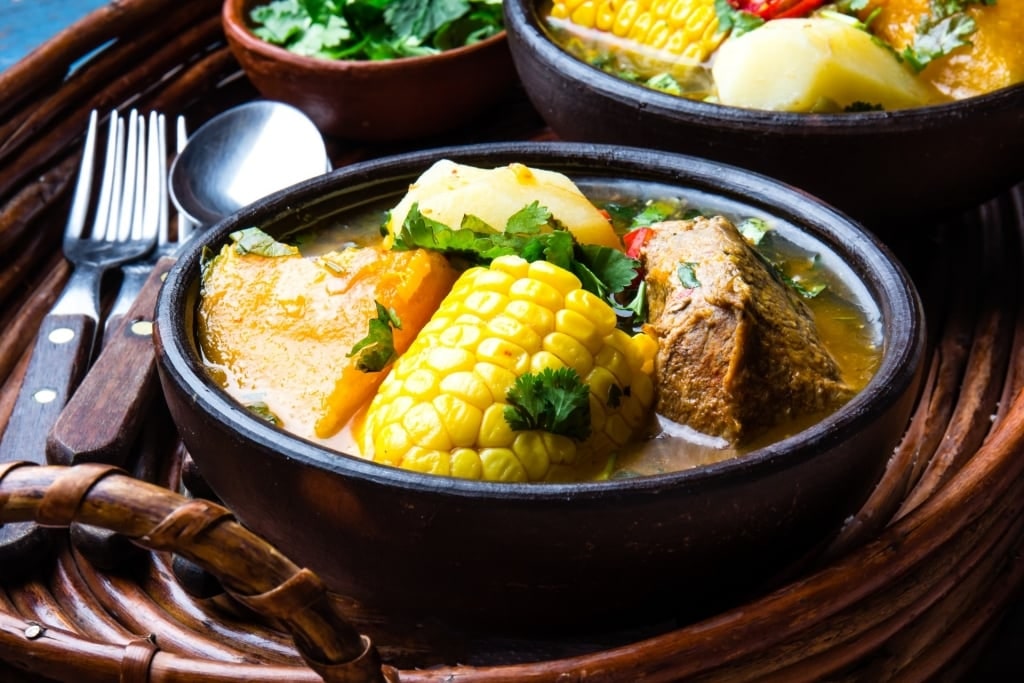
Cazuela
This soup is named for the shallow, unglazed, earthenware pot in which it is traditionally served. Found in Chile and Peru, with variants elsewhere in the region, it’s a hearty dish, thick with meat and vegetables.
Ingredients usually include chicken, beef or lamb, with squash, and/or potatoes as a filling carb. Flavor is added with chili and peppers—but every cook will have their own ingredients.
Cazuela is one of the most popular dishes in Chile. Etiquette states that you should finish the soup first, then eat the remaining meat and vegetables.
Choripan
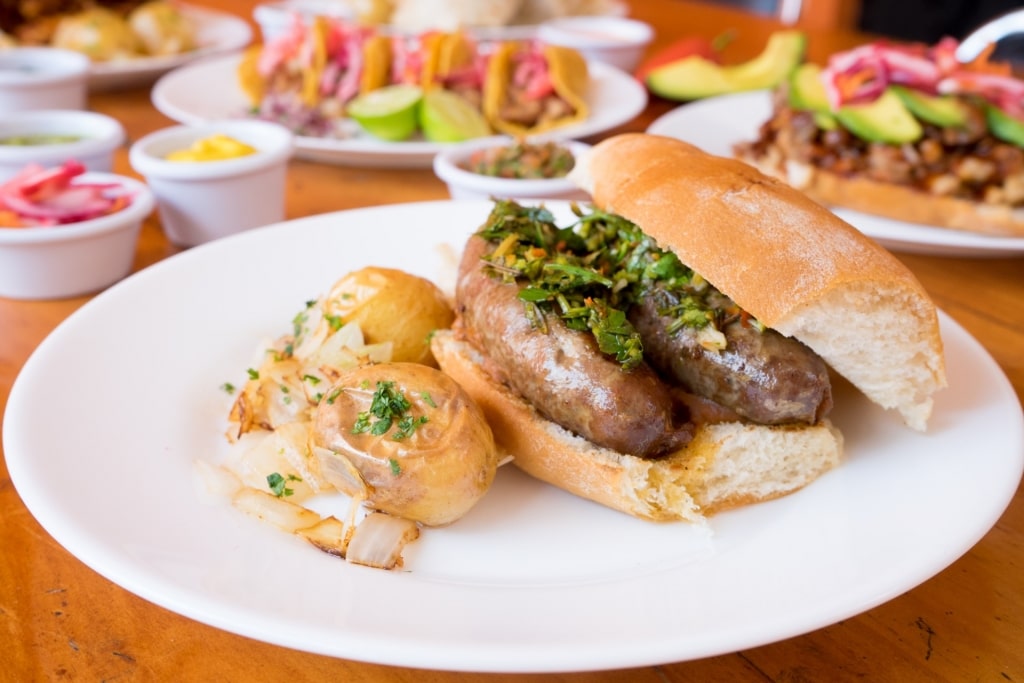
Choripan
Add grilled chorizo (sausage) to a bread (pan) roll, and you have a choripan. It’s the South American version of a hot dog, usually with much better quality ingredients.
In Argentina, the home of the choripan, the chorizo is made from beef or pork. It’s split down the middle, butterfly-style, making it easier to add sauces such as the famous Argentine chimichurri.
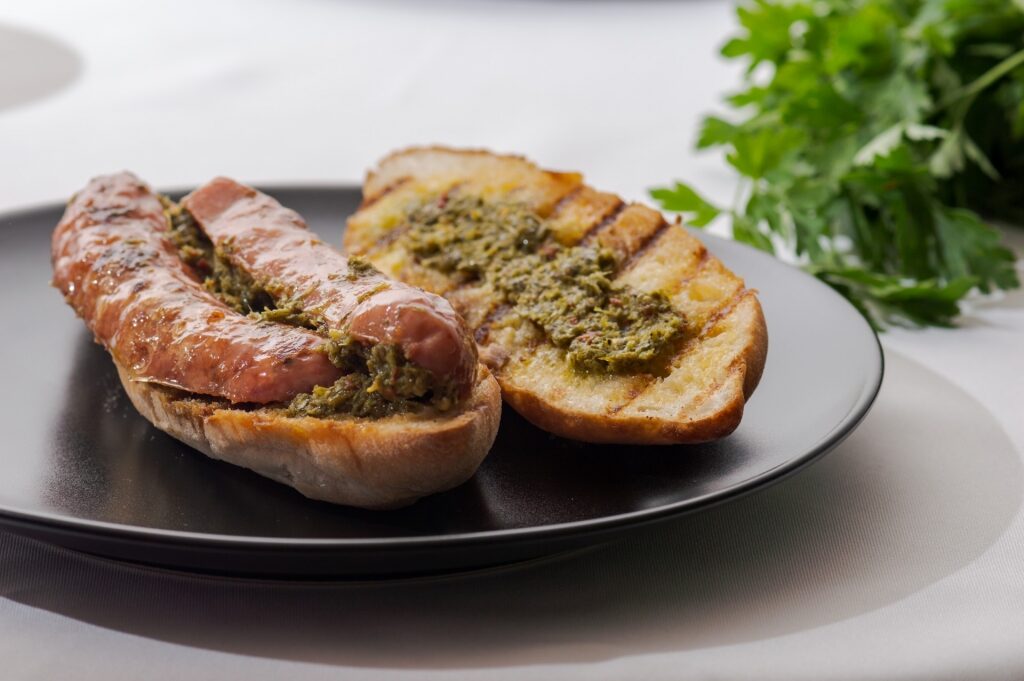
Choripan
The bread is equally important, usually a crusty French baguette-style roll with a soft interior. The mix of flavors, textures, hot sausage and cool bread is all part of the experience.
Empanadas
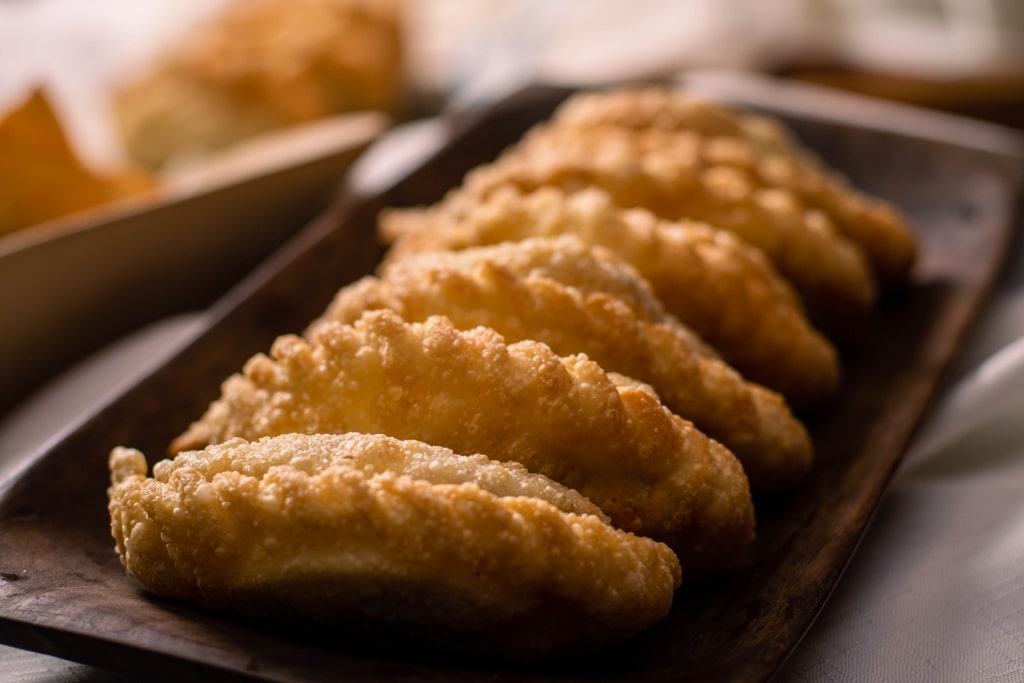
Empanadas
Empanadas are deep-fried or baked pastries filled with meat, cheese or other ingredients. A common South American food, they are particularly associated with Argentina, where they have their own annual festival.
This Argentine version is usually half-moon shaped, and has roots as a quick, easy meal for workers. Nowadays, empanadas are sold in bakeries everywhere as a lunchtime treat.
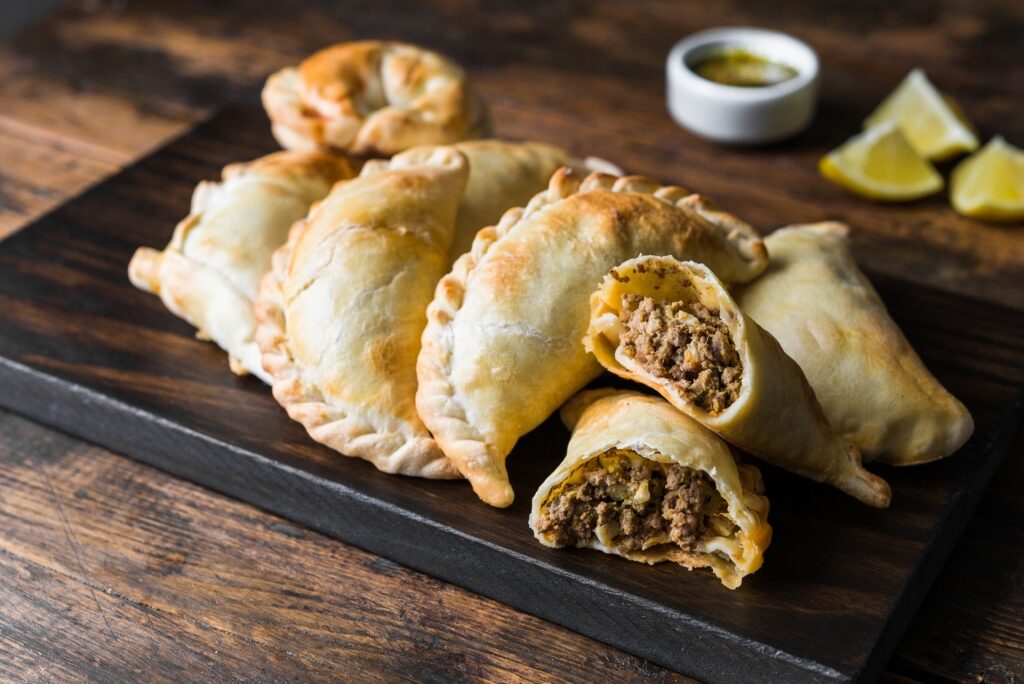
Empanadas
Good Argentine ground beef is a popular filling, enriched with lots of onions, garlic, paprika, and other pepper. Fashionable chefs experiment with their own exotic fillings as well, of course.
Chivito
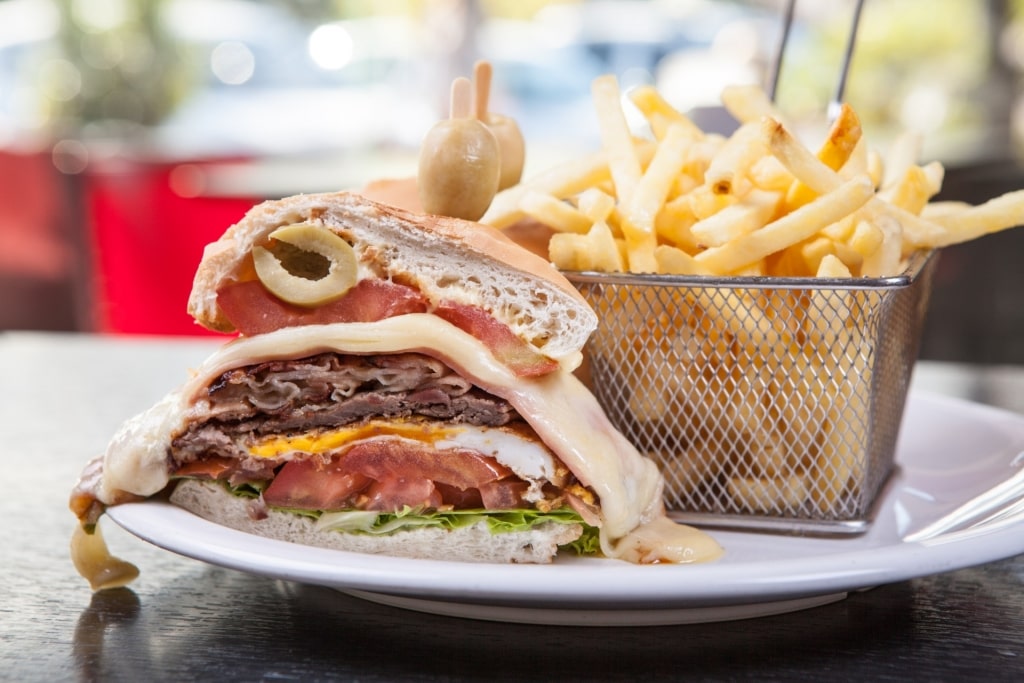
Chivito
Argentina and Uruguay seem to compete in finding imaginative ways to serve up good beef. A chivito (“little goat”, although there’s no goat meat in the dish) is a serious contender from Uruguay for one of the best.
A popular Uruguayan food, it’s a sandwich made with thinly sliced beef from the asado, or barbecue. You then add ham, melted cheese, lettuce, tomato, mayo, and a fried egg, then serve with French fries.
Chivito is as much of a meal as it sounds, a sort of hamburger on steroids. It’s the national dish of Uruguay, even if adding bacon turns it into a “chivito canadiense”.
Feijoada
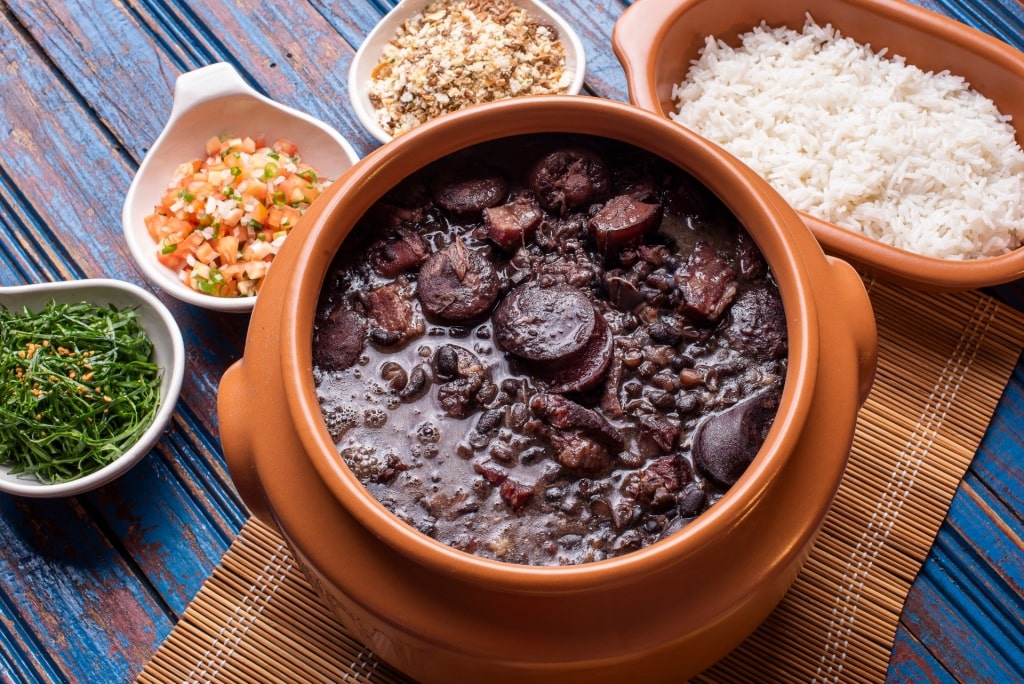
Feijoada
This may be the most well-known of all Brazilian dishes, a dish of black beans, pork, tomato, cabbage, and carrot. It’s perhaps a surprisingly hearty meal for such a tropical South American country.
Feijoada’s origins probably lie in the country’s slave history, when offcuts of pork and offal were used to make a stew. It’s now the country’s national dish, enjoyed by everyone as a family meal on weekends.
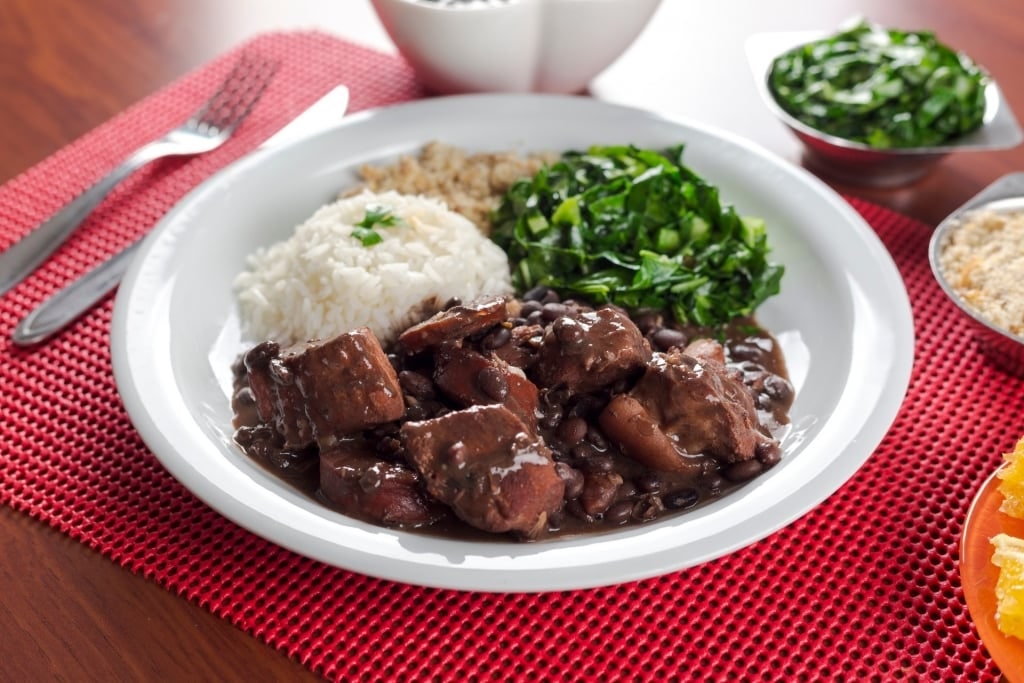
Feijoada
Feijoada is traditionally served with white rice, oranges (to help digest the beans), and kale. It’s also topped with farofa, toasted cassava flour.
Read: What Is Brazil Known For?
Bandeja Paisa
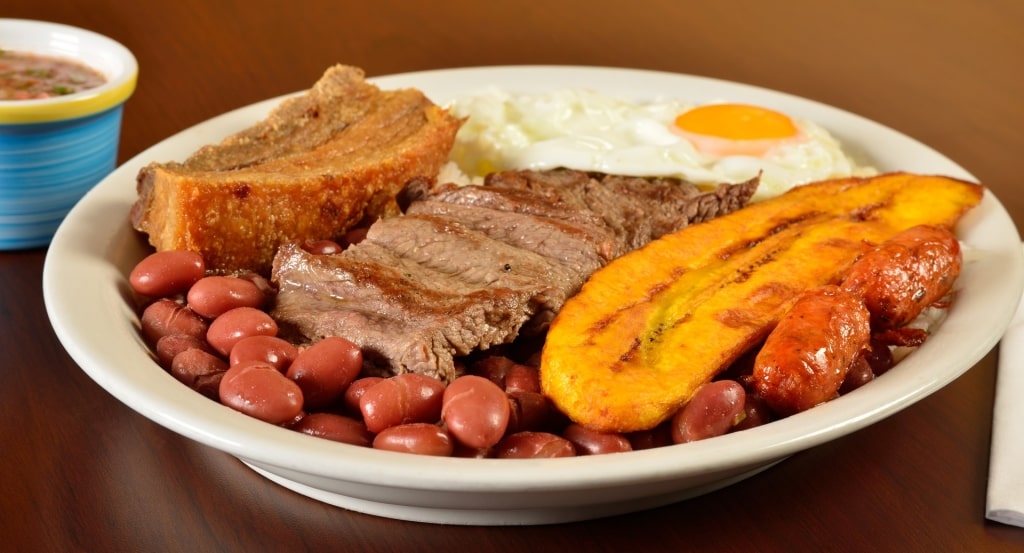
Bandeja paisa
This worker’s meal from the Pasia region is now thought of as the national dish of Colombia. The word “bandeja” means “platter”, which gives you a good indication of its size.
Once a protein-packed farmer’s breakfast, bandeja paisa has evolved into something much more upmarket. It now has everything from sausage and black pudding, to rice, beans, plantain, crackling, avocado, arepa, and a fried egg.
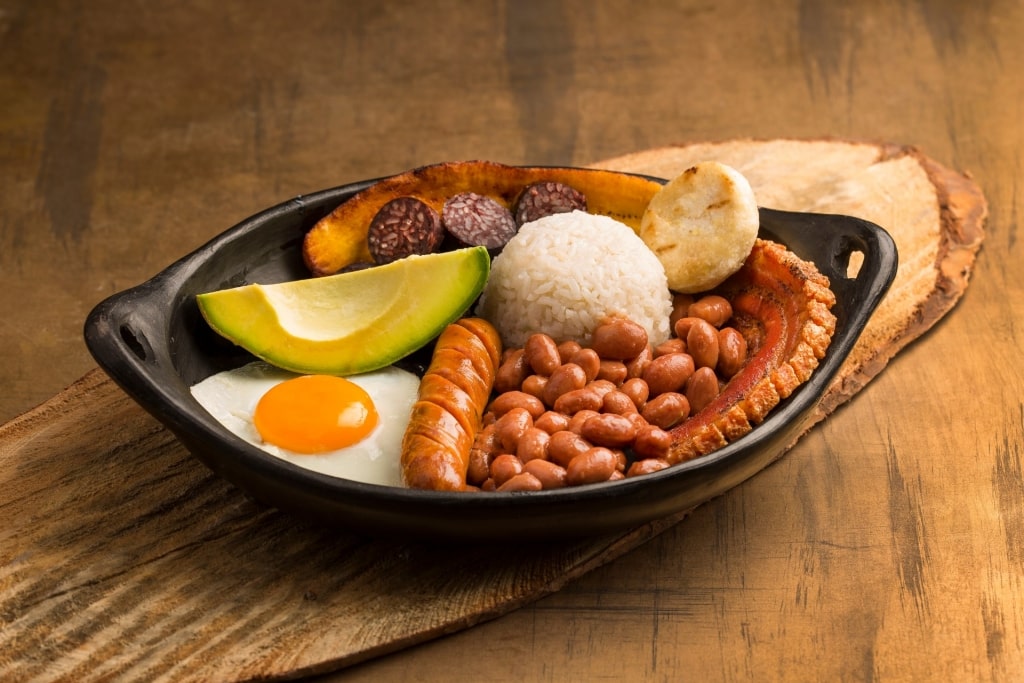
Bandeja paisa
Most restaurants allow you to order a half portion, which is a good place to start for a beginner. Think of it like a full English or American breakfast: perhaps not something you want to eat every day, but a real guilty pleasure.
Read: Best Things to Do in Cartagena, Colombia
Aji De Gallina
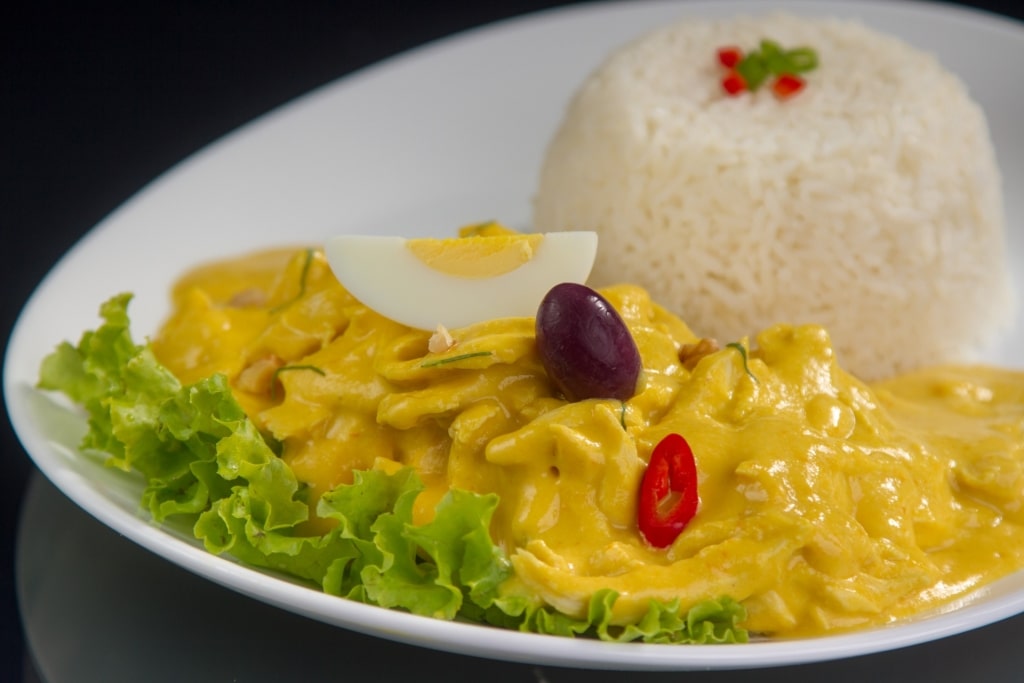
Aji de gallina
Like many a chicken dish, aji de gallina is real comfort food for Peruvians. It’s made of spicy shredded chicken, with a rich, creamy sauce.
The sauce is based on onions, garlic, walnuts, and cheese, thickened with bread, and flavored with aji amarillo chili, pepper, and herbs. It is served with white rice, then garnished with black olives.
Aji de gallina means “hot chili hen”, which tells you that the preferred chicken is one with a stronger flavor. “Pollo” is a younger bird, blander, and whiter meat—an important distinction for this dish.
Chorizo
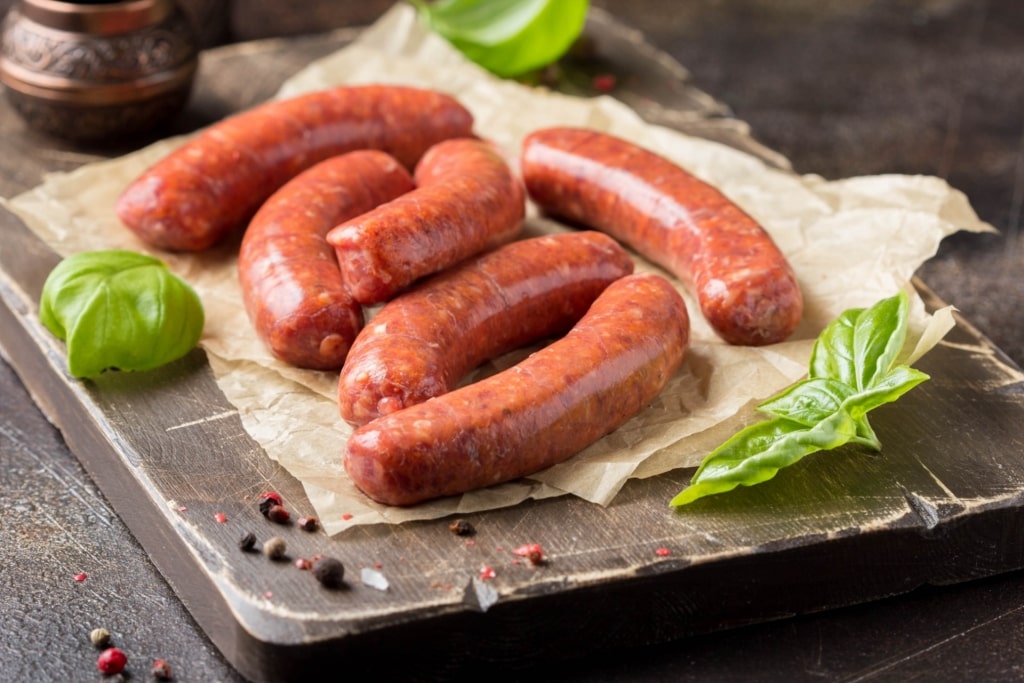
Chorizo
In South America, as in Spain, a chorizo is a sausage made with ground meat (usually pork). Spices, such as cinnamon, give it a reddish color as well as rich flavor.
However, the local version is much less cured than the hard Spanish style, and less spicy. That’s why you might also see the name “chorizo español” on menus.
In Argentina or Uruguay, you’ll also commonly find chorizos made with local beef. Whether pork or beef, they are the most similar in terms of appearance and taste to a North American sausage.
Coxinha
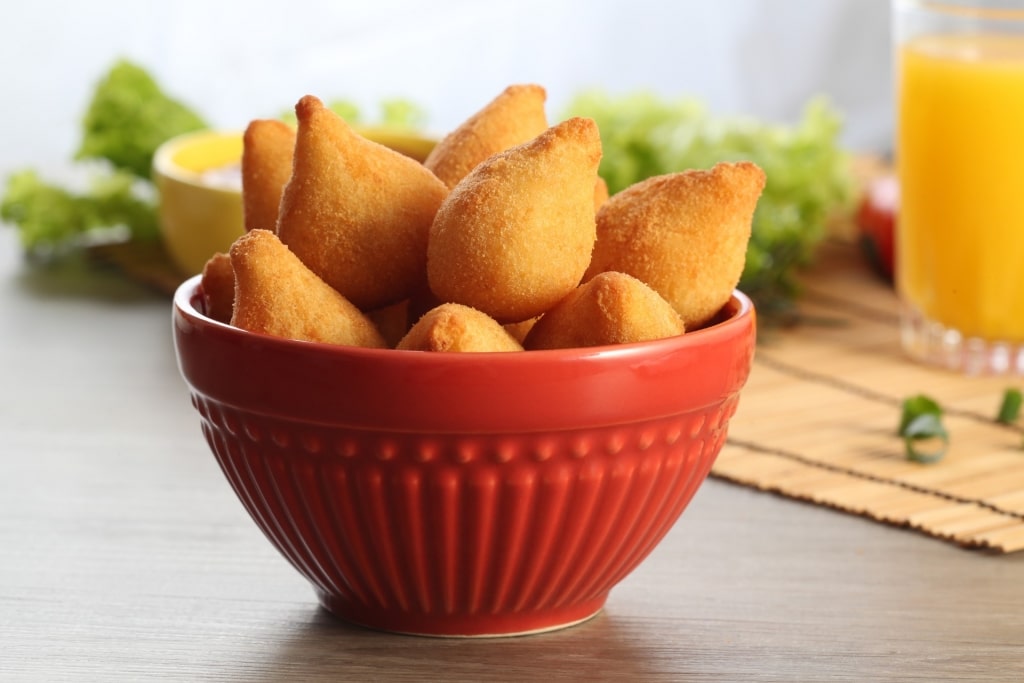
Coxinha
You’ll see these intriguing little croquettes sold everywhere in Brazil as street food. They are deep-fried parcels of chicken and cream cheese.
Molded into the teardrop shape of a chicken thigh (the name means “little thigh”), they are breaded, then fried until golden. Their origins are in São Paulo, where they were first sold at factory gates.
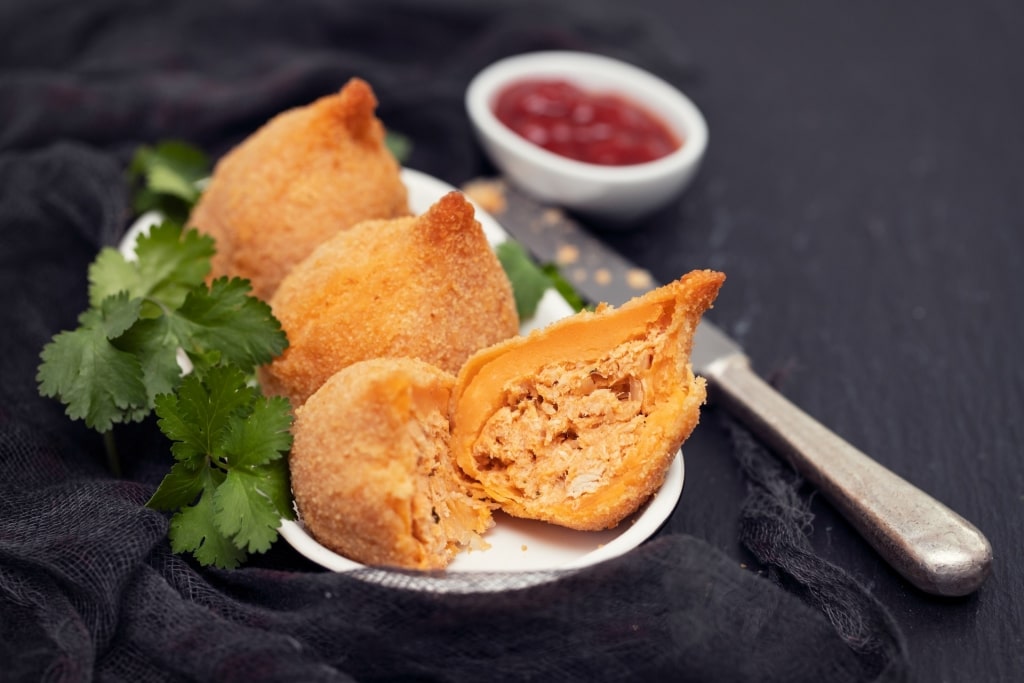
Coxinha
A legend says that coxhina were made for the son of a Brazilian princess who only liked chicken thigh meat. Whatever the truth, they are a food much beloved of children.
Pastel de Choclo
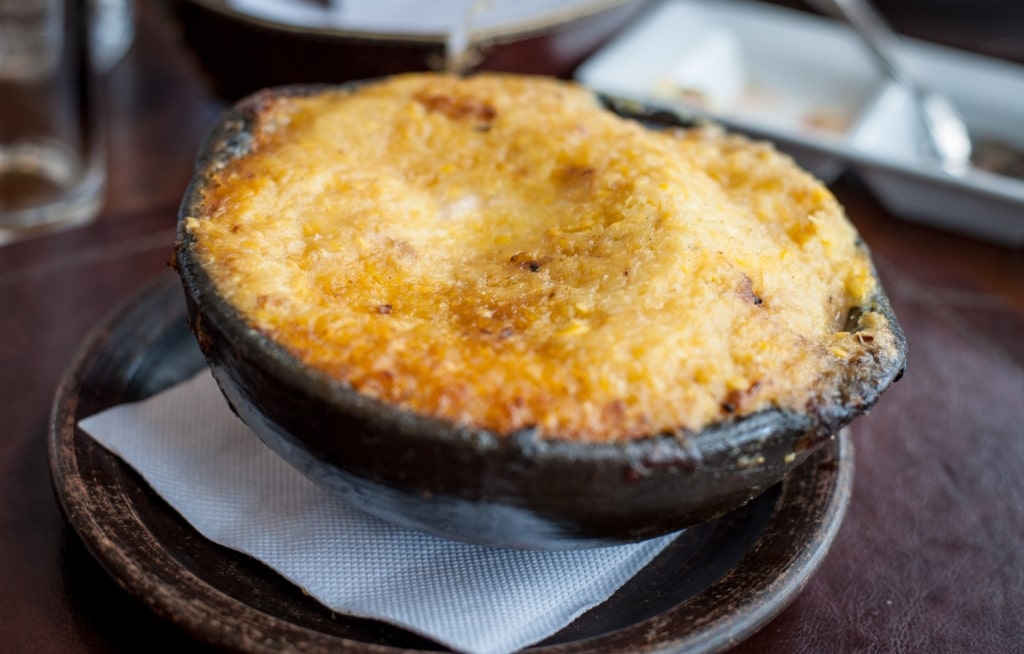
Pastel de choclo
This popular dish is a sort of shepherd’s pie, but topped with corn rather than potato. “Choclo” is corn (maize), pounded into a flour, then mixed with butter and basil, before being layered over a casserole, and baked.
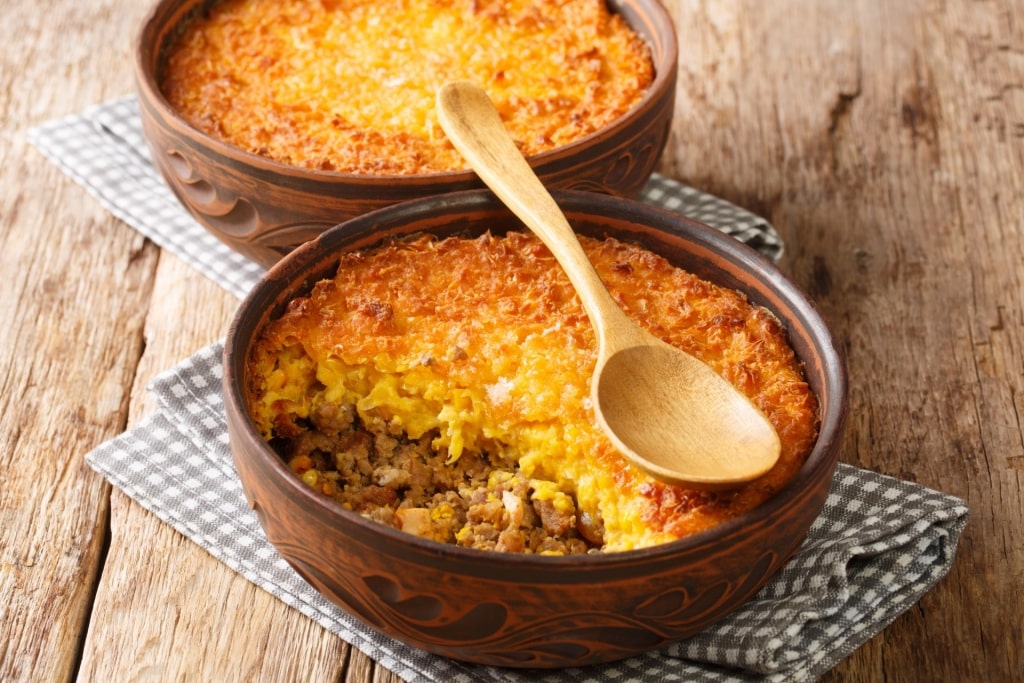
Pastel de choclo
The casserole itself will contain “pino”, which is a traditional mix of ground beef with hard-boiled eggs, garlic, onion, and olives. Raisins are sometimes also added, while a sprinkling of sugar on the choclo helps the crust to brown.
Pastel de choclo is one of Chile’s most popular dishes. However, if you ask for pastel de choclo in Peru or Bolivia, you’ll be eating a delicious sweet corn cake.
Read: Best Things to Do in Chile
Encebollado
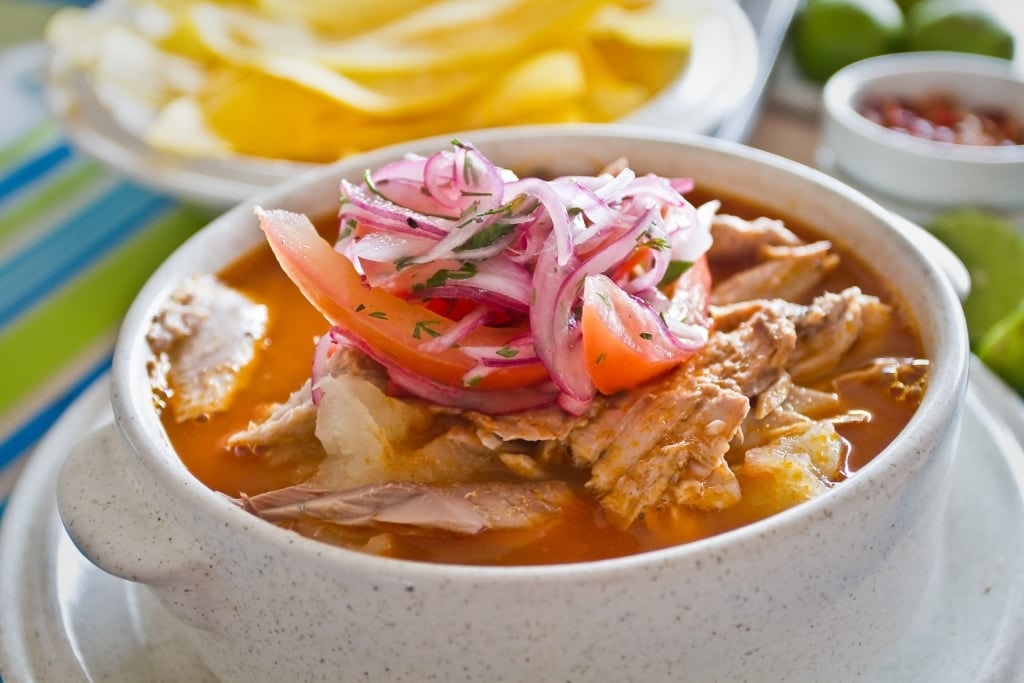
Encebollado
The national dish of Ecuador is this fish soup, made distinctive by the use of lots of onions. Its name means “onioned”, so you can’t say you haven’t been warned.
Fresh tuna is the fish traditionally used, with the addition of cassava, tomato, onions, cilantro, and a variety of spices. A pickled onion and tomato salsa is also added to the soup when served.
This salsa, or “curtido”, is a must-have for almost any meal in Ecuador. It’s made with sliced onion and tomato marinated with lime juice and cilantro.
Platanos Fritos
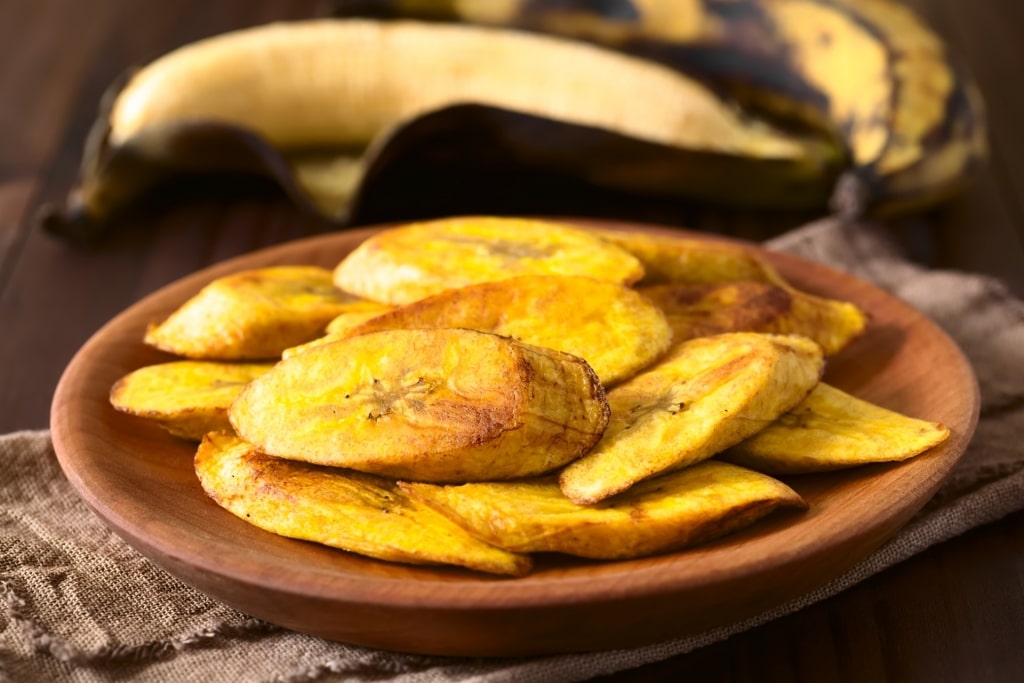
Platanos fritos
Fried plantains are common in large parts of Africa, Asia, the Caribbean, and most of Latin America. If you’ve somehow missed tasting them before, you’re in for a South American treat.
They are made by frying ripe plantains in oil until they are brown and crispy. They can then be served as either a sweet or savory dish.
As a savory, they are often eaten as a side like french fries, garnished with various salsas. Riper plantains make for a sweet dessert, with sauces such as chocolate, cream or jam.
Bolon de Verde
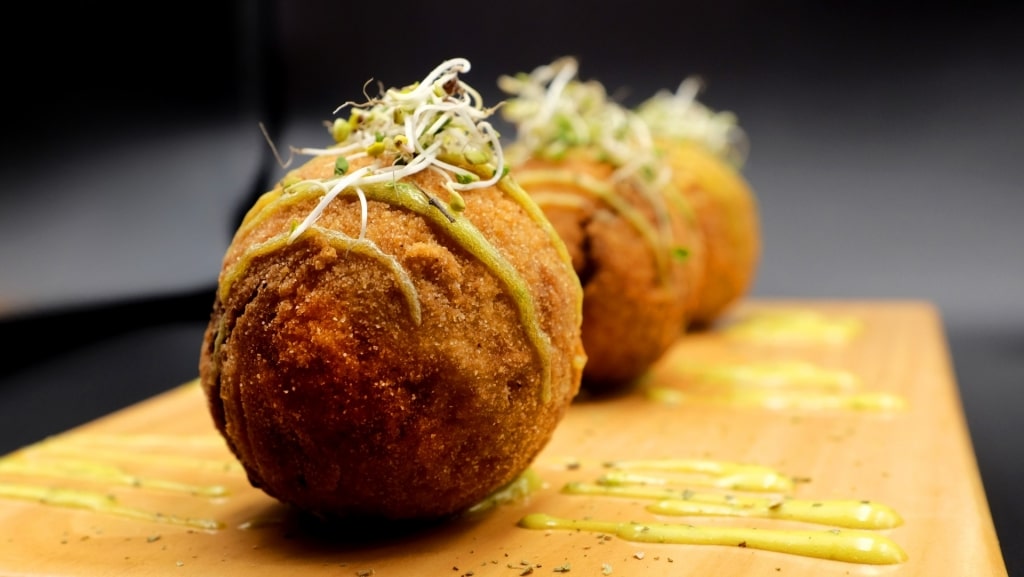
Bolon de verde
This Ecuadorian breakfast dish is a carb-rich ball of mashed green plantain filled with cheese, bacon, or pork crackling. It’s deep fried until crispy and served with fresh fruit, such as papaya or guava.
Bolon de verde translates as “green (plantain) balls”, with Ecuador being the world’s largest producer of plantains. It’s a great breakfast and goes well with a cup of strong coffee.
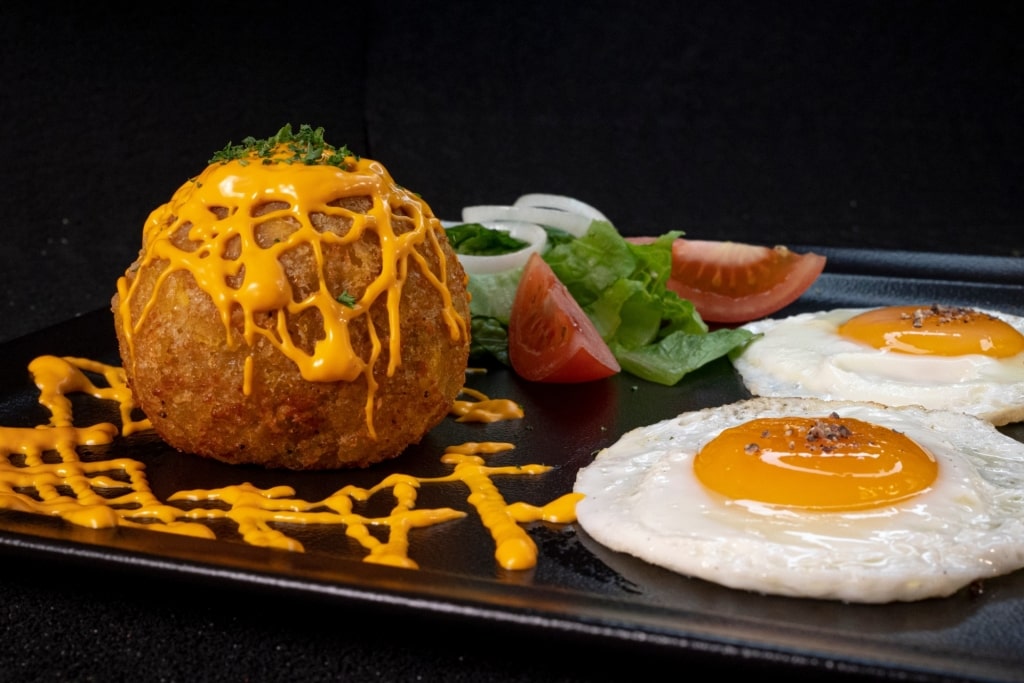
Bolon de verde
A common option in restaurants is to add a fried egg. Hot sauce is also a given, bringing the whole dish to life.
Lomo Saltado
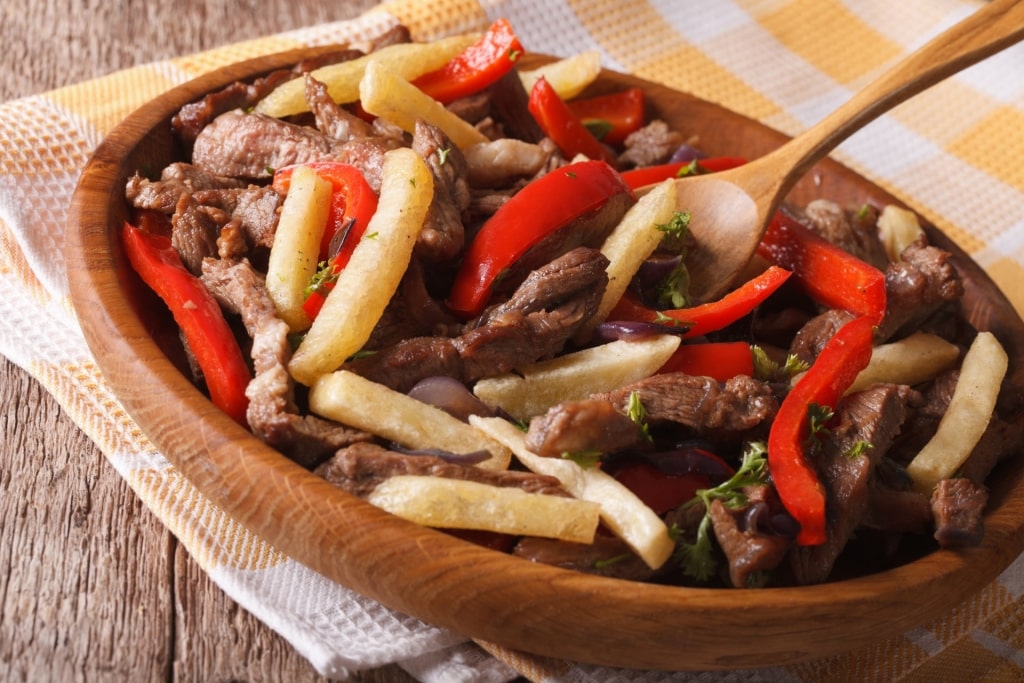
Lomo saltado
This traditional Peruvian dish was much influenced by 19th-century Chinese immigrants (“chifa” is the local name for this fusion cuisine). Its stir-fry style will be very familiar to anyone who has ever eaten in a Chinese restaurant.
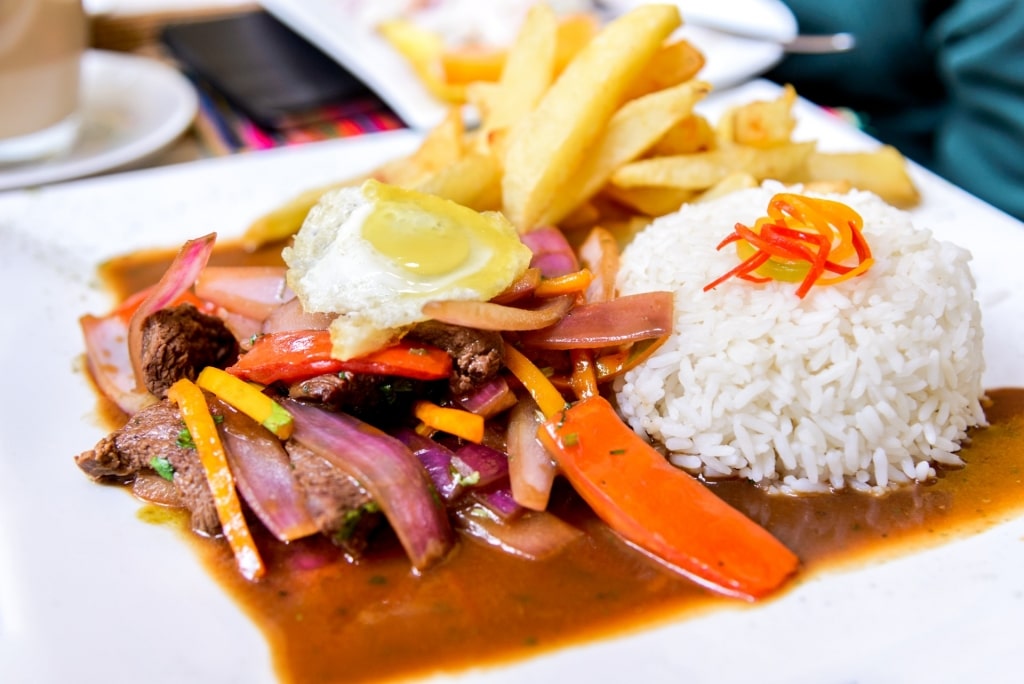
Lomo saltado
Lomo Saltado is made with marinated beef (or sometimes chicken), thinly sliced, then fried with onion, chili, and tomato. Rice or French fries are served on the side.
The dish is a restaurant staple throughout Peru, often featured as the daily special. It’s practically a tradition now to enjoy it with a can of the famous Inca Kola.
Dulce de Leche
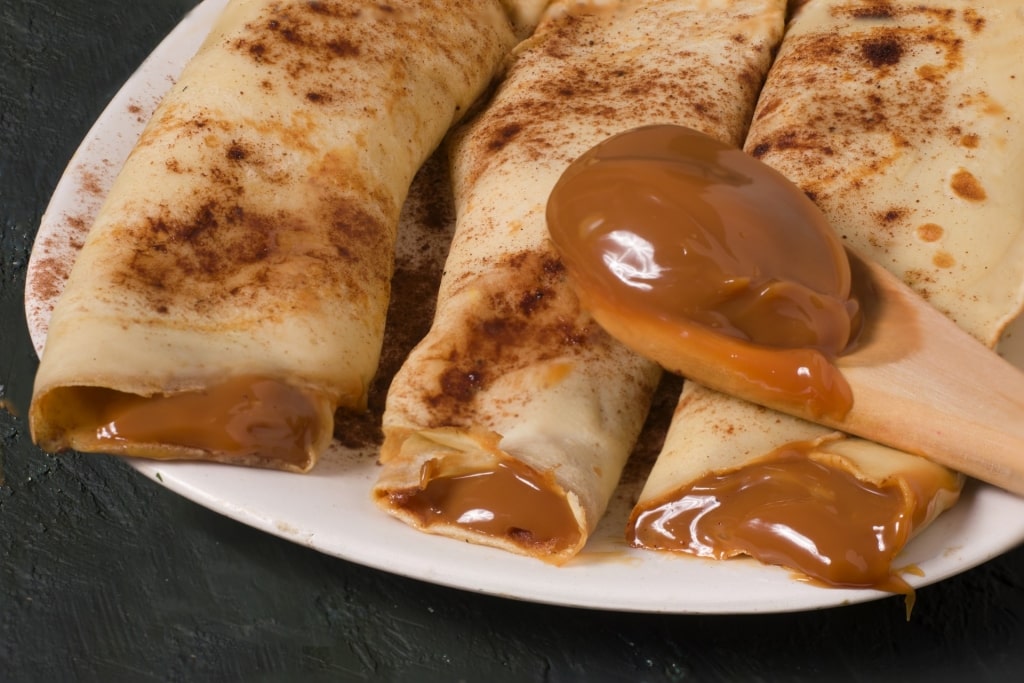
Dulce de leche
Dulce de leche ice cream is good enough to be one of the best desserts in the world. It’s made with a milk caramel, the result of gently cooking milk into a smooth, thick sauce.
Dulce de leche literally means “sweet from milk” and is found as an ingredient in many Argentine dishes. It’s spread on bread or toast, poured over pancakes, or sandwiched into alfajores.

Dulce de leche
An Argentine historian was brave enough to suggest that this milk “jam” was first made in South-East Asia. He suggests we should thank Filipino sailors for bringing it to the Americas, from where it reached Argentina via Mexico.
Canjica/Mugunzá

Canjica
This Brazilian pudding is known by different names, depending on the region, but is the same dish of milk porridge made with white maize kernels—somewhat like grits. Flavored with shredded coconut, it’s sprinkled with cinnamon or nutmeg.
Served warm in winter, it is also chilled as a refreshing summer dessert. The combination of sweet and spicy flavors is an unusual one.
Every cook (or consumer) has their own variations, from extra spices or chocolate chips to condensed milk or nuts. A clove was also a traditional extra, now more commonly replaced with ground cloves.
Alfajores
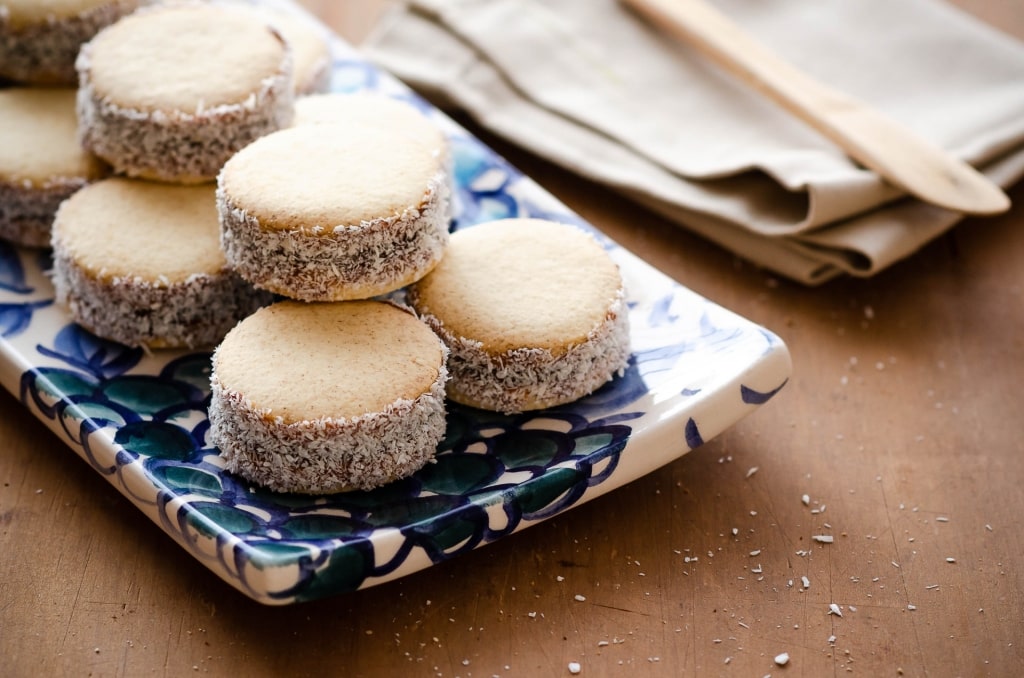
Alfajores
These round cookies are very popular throughout South America, but most associated with Peru, Argentina, Chile, and Uruguay. They are eaten for breakfast, afternoon tea, or as a snack at any time.
Argentina is the biggest consumer of alfajores in South America. Dulce de leche is the usual filling, sandwiched between two baked biscuits.
The most popular flavors are chocolate and coconut. Few visitors come away without a souvenir box of these addictive treats.
Read: Best Places to Visit in South America
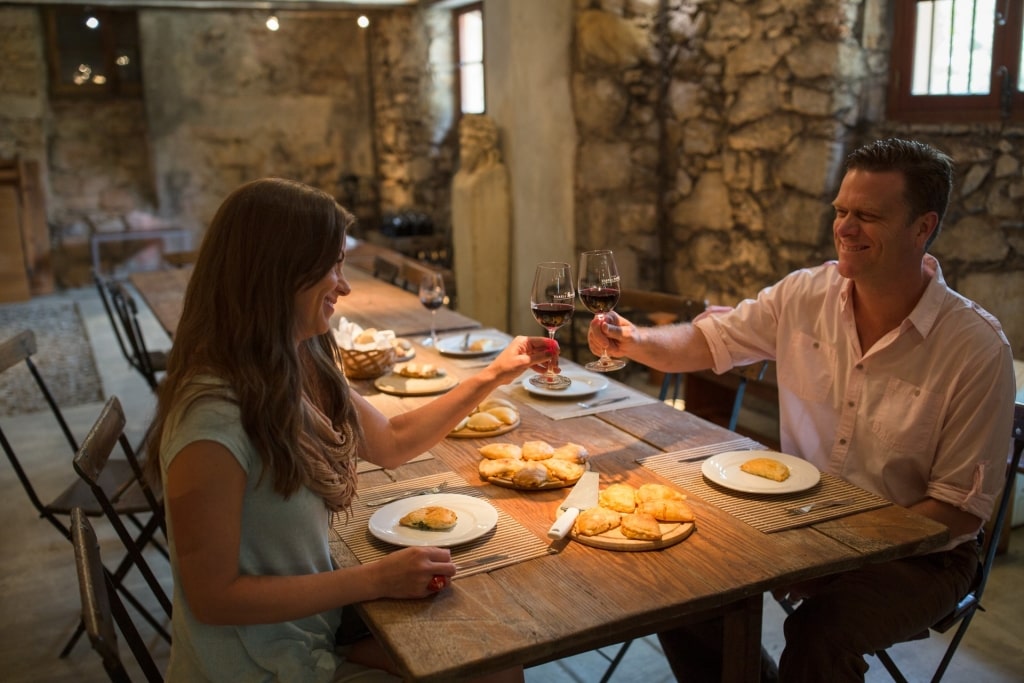
Wine tasting in Montevideo, Uruguay
Has this guide to the best of South American food given you a taste for a visit? Then browse our South America cruise itineraries to find the right time and place to embark on the trip of a lifetime.
